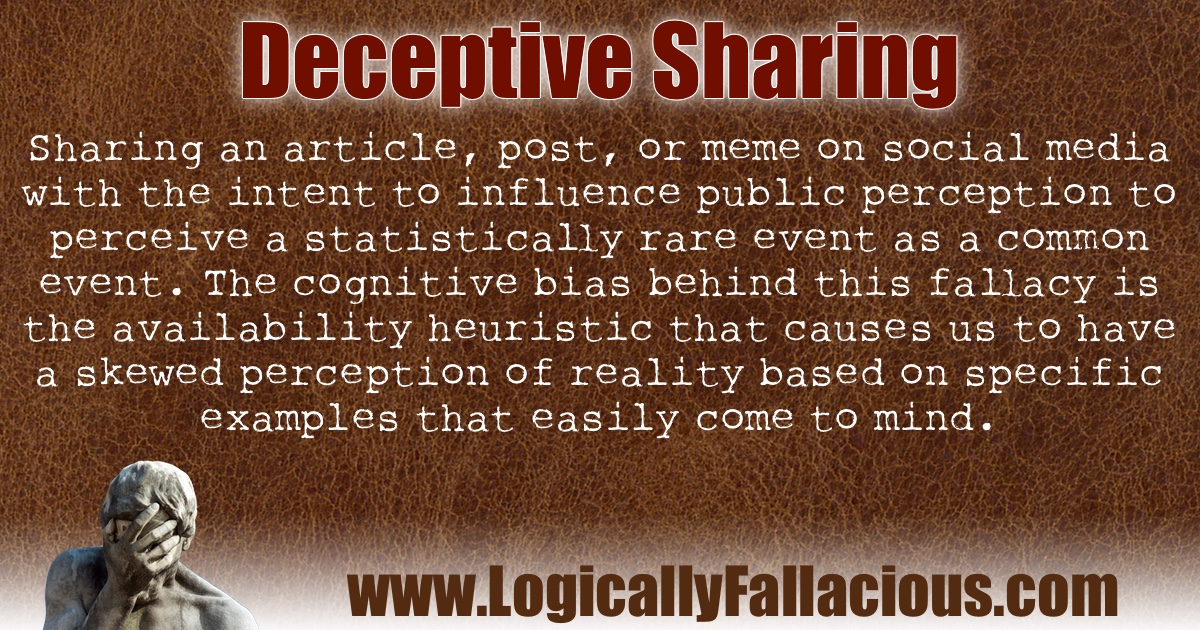Description: Sharing an article, post, or meme on social media with the intent to influence public perception to perceive a statistically rare event as a common event. The cognitive bias behind this fallacy is the availability heuristic that causes us to have a skewed perception of reality based on specific examples that easily come to mind.
Like most fallacies, we have the fallacious tactic by the one who shares an article, post, or meme on social media depicting a statistically rare event with the intent to manipulate public perception of the event as a common event. Someone who views an article, post, or meme on social media depicting a statistically rare event and believes it to be a common event, has been a victim of deceptive sharing and is using fallacious reasoning. It is also possible for those sharing content to be deceived, themselves.
There is a strong, implied argument with the share that the event is far more common than it actually is. If the content is shared with an explicit argument claiming that the event is more common than it really is, then there is no fallacy; it is a factual error. What makes this fallacious is the implied argument that remains unsaid but clearly implied.
Logical Forms:
[fallacious tactic]
Event X is statistically rare.
Person 1 shares article, post, or meme of an instance of event X with the intent to deceive others in thinking event X is far more common than it is.
[fallacious reasoning]
Event X is statistically rare.
Person 1 shares article, post, or meme of an instance of event X.
Person 2 believes the event is far more common than it is.
Event X is statistically rare.
Person 1 shares article, post, or meme of an instance of event X, believing that event X is far more common than it is.
Example #1: During the COVID-19 pandemic, there was much debate on reopening schools. Like with many issues, there was a strong partisan split where liberals were mostly against sending kids back to school, and conservatives were mostly for sending kids back to school. Several of my liberal friends commonly shared stories about kids getting sick, including this story posted with no comment nor argument:
Health officials in Georgia confirmed this week that a 7-year-old boy with no underlying health conditions has died from the coronavirus, the youngest fatality from the pandemic in the state so far.
The strategy is to let those who comment make the arguments that the one posting is not willing to make nor defend, and the one who shared the article can remain blameless.
Children, especially healthy children with no underlying health conditions, dying from COVID-19 is extremely rare. Sharing stories of this happening gives people the impression that it is far more common than it actually is, causing them to make important decisions based on a poor understanding of the data.
Example #2: Some people who were adamantly against wearing masks shared the story published by the New York Post on May 6th, 2020, with the headline “Two Boys Drop Dead in China While Wearing Masks During Gym Class.” Ignoring the problem with causation (i.e., it has not been determined that the masks had anything to do with the deaths), the purpose for sharing the article is very clear: To attempt to vindicate the sharer’s anti-mask-wearing position. The fact is, recorded instances of people dying from wearing masks are exceptionally rare.
Exception: It may be the case that statistically rare events are also “feel good” events that have no manipulative intent, for example, sharing a story about a local child who saved his family from a gas leak. There is no implication here that kids saving their families from gas leaks is a common occurrence.
A more questionable exception is the statistically rare, “feel good” event that may be shared with the intent to manipulate. An example is FOX News, with their regular posts of “hero cops” who save babies, help old ladies across the street, or save the world from intergalactic invaders. The manipulative intent is debatable. While the public does love these stories, they also counter the police brutality stories commonly posted by mainstream media.
Tip: Remember the principle of charity. If you are not confident that the sharer is implying that the event they are sharing is far more common than reality dictates, ask, “what is the reason you are sharing this?”

This a logical fallacy frequently used on the Internet. No academic sources could be found.